
Universidade Fernando Pessoa
Porto, Portugal

Seismic-Sequential Stratigraphy
E. 2) Unmigrated versus Migrated Profiles (cont.)
Geological knowledge is absolutely necessary to perform good seismic interpretations, particularly in complex tectonic areas. However, several years ago, seismic interpretation was the realm of geophysicists trained in seismic processing but without geological knowledge. When I was a young geologist, just very few geologists were allowed to use seismic lines. I can never forget, when I asked authorization to attend an internal Exxon short course with P. Vail as instructor. My boss was extremely surprised. For him (a geophysicist), a geologist attending such a course, was a loss of time. So, I was obliged to use seven days of my annual vacations to attend the course.
Let’s see some real seismic examples, illustrating and probably explaining why at my time the interpretation of the seismic lines was mainly made by geophysicists
Ex: 1- Unmigrated seismic line
Before the advent of migration processing, i.e. before the 80's, explorationists were obliged to interpret, in structural and stratigraphic terms, unmigrated lines such as the one illustrated below (Plate 57).
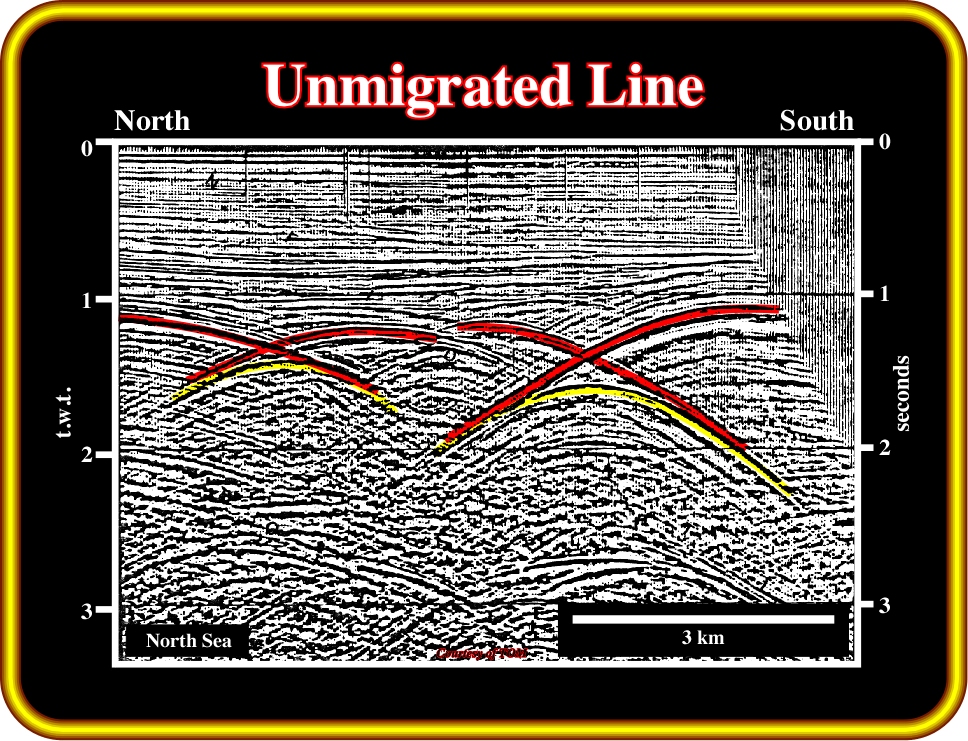
Plate 57- This old unmigrated seismic line comes from a relatively quite tectonic North Sea area. Knowing the regional geological setting and the fact that a synform seismic response can be a convex upward reflection (when centre of curvature is in the subsurface, see Plate 55), it is relatively easy to predict on this line two syncline structures (see Plate 58).
Ex: 2- Migrated seismic line
Migration processing was extremely helpfully for seismic interpreters, particularly geologists. A migrated line looks much like a geological cross-section. Comparing the lines illustrated on Plates 57 and 58 is sufficient enough to understand the impact of migration.
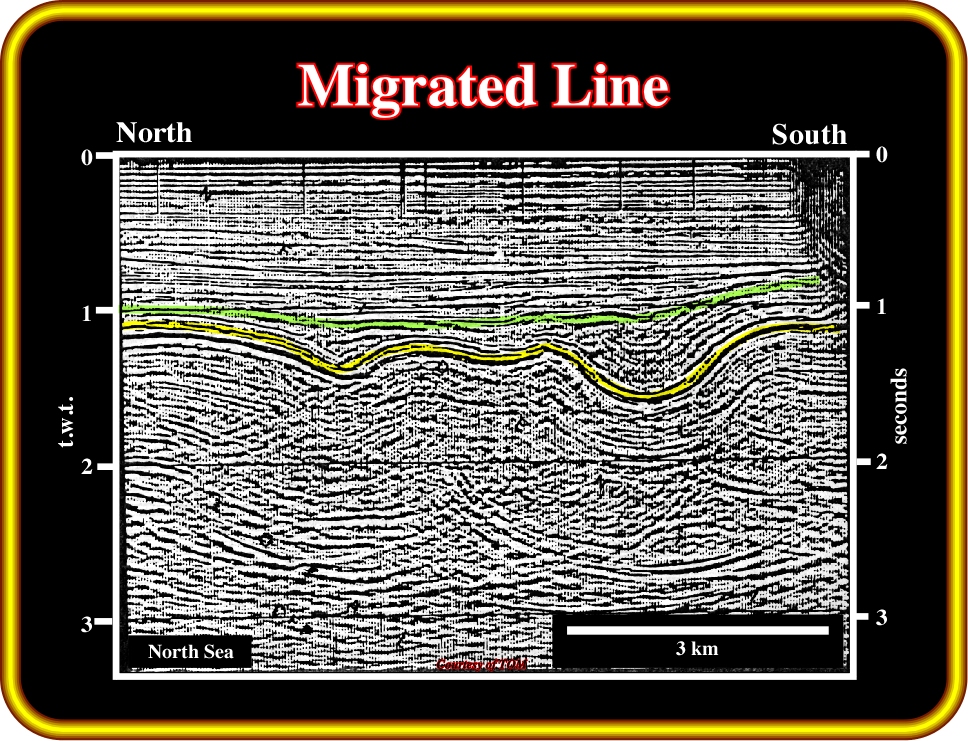
Plate 58- This seismic line is the migrated version of the previous unmigrated line (Plate 57). In spite of the fact that a migrated seismic line looks like a geological cross-section, interpreters must never forget: (i) the vertical scale is in time and (ii) seismic artifacts, as those induced by lateral changes of velocity, are almost always present. In other words, interpreters must differentiate the reflectors with geological meaning from those unrelated to the geology of the area.
Since migrated seismic lines became available for interpretation, the organization of the teams in charge of the geological interpretation of seismic data changed drastically due to massive arrival of geologists. At that time, geologists were trained to understand the differences between seismic lines and geological cross sections, in order to avoid misinterpretations induced by seismic artifacts. However, with time, training courses for geologists became rare. Nowadays, the majority of geologists arriving in interpretation teams do not know the driving principles of interpretation. I hope that this seminar can help not only geologists but geophysicists as well.
Ex: 3- Offshore Norway
On the unmigrated seismic line illustrated on Plate 59, the recognition of the different sedimentary basins and stratigraphic phases requires from interpreters a certain a priori knowledge.
Plate 59 - This old unmigrated seismic line comes from offshore Norway. So, to start the interpretation, theoretically from bottom to top, interpreters must recognize (i) type-rift basins and (ii) an Atlantic-type divergent margin (following the A. Bally’s basin classification). These basins are separated by a major unconformity, which corresponds to the break-up of the Pangea lithosphere. In addition, in the margin, they must try to individualize the transgressive, that is to say, the backstepping and the regressive or forestepping phase. Interpreters just recognize on seismic lines what they known. They must progress from the general to the particular and not the opposite.
The interpretation of such lines depends mainly on the geological knowledge of interpreters: (i) geological context, (ii) basins classification (Bally’s classification), (iii) driving concepts of Sequential Stratigraphy, (iv) driving mechanisms of seismic reflections, and so on.
The depth migrated version of the previous line is shown in Plate 60. Its geometry looks similar to a geological cross-section. Geological interpretation is easier than on the previous un-migrated version. This is particularly true for young geologists. However, it must be noticed that: (i) the scales (horizontal and vertical) are different, (ii) the profile is not at natural scale (1:1), (iii) the vertical scale is exaggerated.
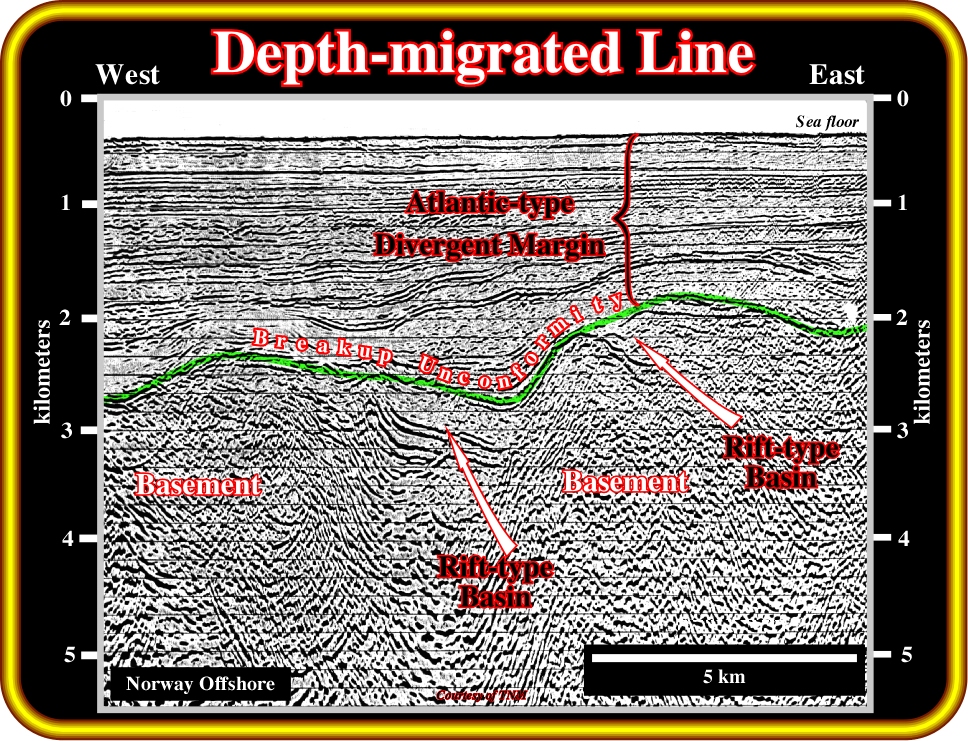
Plate 60 - This line is a depth migration (65°) version of the line illustrated previously (Plate 59). However, the vertical scale is exaggerated. Hence, interpreters must take into account that geological laws require a natural scale, that is to say, the same vertical and horizontal scales. On this version, the infrastructure (basement), the rift-type basins and the Atlantic-type divergent margin are much more easy to recognize than on the un-migrated version (Plate 59).
As said previously, to migrate a seismic line correctly, it is necessary to define fully the velocity field of the ground, i.e. specify the value of velocity at all points. In practice, for purposes of migration, an estimate of the velocity field is made from prior analysis of the non-migrated seismic section, together with information from borehole logs when available. In spite of this approximation almost invariably migration leads to major improvement in the seismic imaging of the reflector geometry.
Ex: 4- Offshore Angola
The line illustrated in Plate 61 comes from offshore Kwanza (Angola), in which Salt tectonics induce huge antiform extensional structures, which have attracted explorationists since the beginning of the century (Sinclair Oil Company, 1904).
Plate 61- This old unmigrated line from offshore Angola, where a Cretaceous evaporitic salt layer was deposited near the bottom of the Atlantic-type divergent margin, strongly increases the complexity of the data. Halokinesis, associated with an extensional tectonic regime, developed a sharp tectonic disharmony at the base of the evaporites. The sediments overlying the evaporites are quite deformed, while the infra-salt strata are almost undeformed. This tectonic disharmony does not correspond to a major stratigraphic boundary. In other words, the segmentation of the Atlantic margin sediments into supra and infra-salt strata is a tectonic division. It does correspond to any major stratigraphic feature. The salt induced tectonic disharmony is much more evident in migrated data as illustrated on Plate 62. Notice that the lower part of the major listric fault zone is filled by salt, which is enhanced by a non chronostratigraphic seismic reflector.
In the 70’s, when only unmigrated lines were available, interpreters had a lot of problems to solve to understand the tectonic complexity induced by halokinesis. Nowadays, migrated versions of the old lines and new migrated data, as well as 3D, make interpretation easier. Nevertheless, interpreters must pay attention to potential pitfalls, such as: pull-ups, pull-downs, reflectors’ dips, etc., which are often associated with the available data. The interpretation of the migrated version (Plate 62) is easier than the unmigrated version (Plate 61).
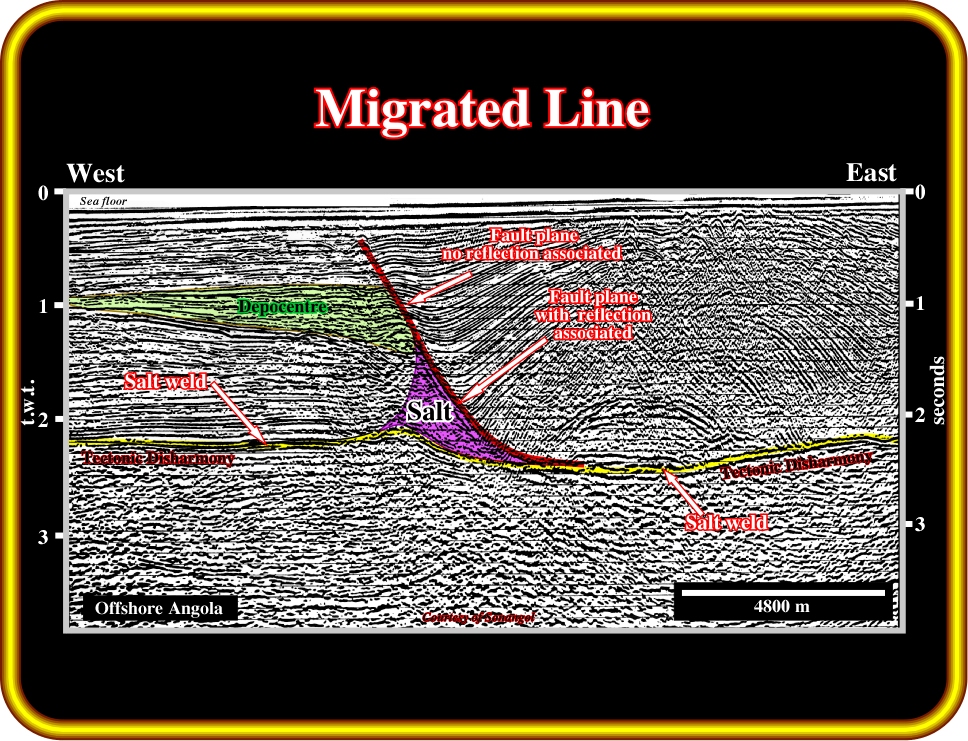
Plate 62- The migrated version of the previous line, illustrated above, in which the majority of the diffractions have disappeared, depicts much better the seismic surfaces (surfaces defined by the reflection terminations) than the unmigrated version Plate 61). The tectonic disharmony, at the bottom of the evaporitic interval, is quite evident. Similarly, the geometric relationships and the internal configuration in the extensional antiform, developed in the hangingwall of the listric growth-fault, are readily recognized. Also, it is easy to notice that, at the present time, the evaporitic interval is not continuous. A salt roller (in the lower part of the listric fault) separates two quite evident salt welds. As theoretically expected, the sediments underlying the tectonic disharmony are almost undeformed, which contrasts with the post-salt sediments.
Actually:
- The majority of diffractions disappeared.
- The reflectors are in a more correct position.
- The vertical scale still is in time. Hence, the dips of the reflectors are apparent and exaggerated.
- Using exaggerated dips as criterion to predict facies and environment is dangerous. Lithological and environment predictions require: (i) Time-depth conversion and (ii) data at natural scale, i.e., at 1:1 scale.
Comparing the unmigrated (Plate 61) and migrated (Plate 62) versions is easy to see:
(i) Migration removing hyperbolic interferences clarify the reflections.
(ii) Hyperbolic features arising from reflection terminations, faulting or other ways, are shrunk to a point by the migration process.
(iii) Antiform structures have a more naturalistic picture on migrated lines: (i) apexes are not moved in position, (ii) flanks are more abrupt.
(iv) Fault planes, and associated morphological traps by juxtaposition, are moved up dip by migration, so a better assessment of the potential closed area is possible.
(v) On the unmigrated line, interpreters are left with the impression of faulting, but it lacks precision. On the migrated line, in the central part of the line, interpreters easily recognize an important listric fault with an eastward vergence and a decreasing hade.
- On lower part the fault plane, where the hade is gentle, a seismic reflector is associated with the fault plane.
- On the apex of the large antiform, several fault planes with opposite vergences can be recognized.
- Non-primary reflections, such as (i) multiple, (ii) reflected refractions, etc. are merely distorted by the migration process, so they can mislead the interpreters.
The Plate 63 illustrates a depth-migrated version of the previous line.

Plate 63- This depth-migration version of the previous seismic line is at natural scale (1:1). Theoretically, the dips of the reflectors correspond to the real dips of the bedding planes. Similarly, the dip of the listric fault plane is real. However, as you already probably noticed, this depth conversion is not perfect. The salt-induced tectonic disharmony should be more or less flat (dipping slightly seaward) and not undulated, as illustrated above. Actually, when this depth-migration conversion was performed, explorationists, due to raft-tectonics, did not properly control the velocity intervals in offshore Angola. Due to halokinesis, in which tectonic inversions are frequent, the majority of the geometrical relationships (reflection terminations) are apparent. Indeed, as we will see later, the reflection terminations on the tectonic disharmony are not downlaps but tilted onlaps. In other words, the reflection terminations are not pristine, but deformed by salt flowage.
Notice that in Plate 63:
- The line is at natural scale.
- The horizontal and vertical scales are metric and equals.
- The dips of the reflectors are real.
- Geological laws, such a Goguel‘s law, Walter’s law, etc., must be respected.
On Plate 65, is illustrated a depth-migrated version of the previous line with exaggerated vertical scale (2.5 x).
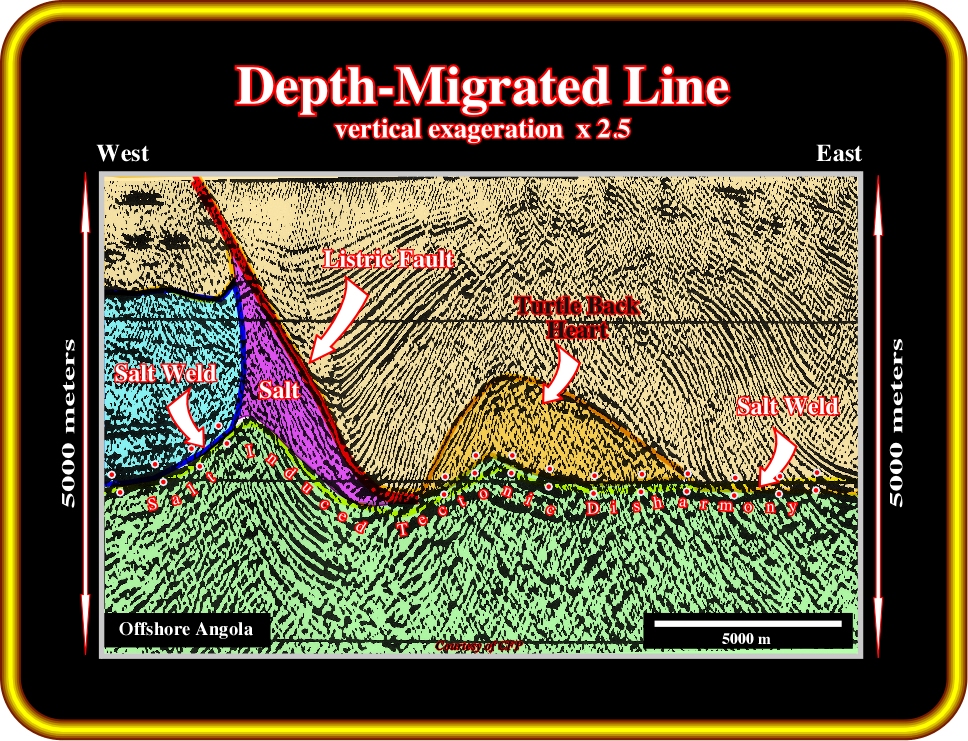
Plate 64- The previous depth migrated line is here illustrated with a vertical exaggeration of 2.5 times. Explorationists and particularly those using workstations or PCs for interpretation of seismic data should never forget that Geology is scale dependent. Indeed, a progradation, for instance, can be interpreted as a continental slope or as deltaic slope (prodelta); it depends on vertical and horizontal scales. On the other hand, geological laws, as Goguel’s law, Anderson’s fault law, etc, can only be applied at natural scale data.
Notice that in this version:
-The dips of the chronostratigraphic lines (primary seismic reflection) do not correspond to the dips of the beds on the ground. They are 2.5 times exaggerated. Dipmeters values (electrical-log) match only with the dips of depth-migrated lines when depicted at natural scale (1:1).
The majority of seismic lines used in interpretation are vertically exaggerated. Under these circumstances, Anderson‘s Law of faulting must be used carefully, since on normal seismic lines, seismic surfaces associated with fault planes have a much higher dip.